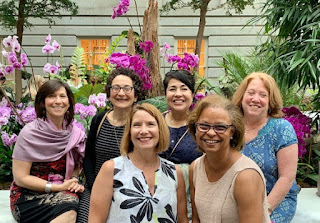 |
Sally, Linda, Danita and Althea (back row); Me and Sheila
(front row) at National Portrait Gallery courtyard
|
But first, a quick Constitutional primer. (Don't take offense. I did this for myself.) The first clause of the 14th Amendment -- the equal protection clause -- ensures equal rights for all "citizens." Sounds good, right? But the second clause of the Amendment makes it clear that women are excluded from its scope. After all, those of the fairer sex were considered a mere appendage to their husbands -- or, if unmarried, their fathers. The natural consequence of this paternalism was to prohibit women from exercising all sorts of rights given to men, including the right to vote.
We were surprised to learn that, despite not having suffrage, a woman ran for President as early as 1872. Victoria Woodhull was nominated for the office by the Equal Rights Party that year, with Frederick Douglass as her Vice President Although Woodhull's support of "free love" for all was not an official part of her platform, it didn't help her campaign. (For the record, her advocacy arose from the double standard in the treatment of men and women who had extramarital affairs. Case in point: Henry Ward Beecher who, according to Wikipedia, is known for "his support of the abolition of slavery, his emphasis on God's love, and his adultery trial." Click here to read more. And yes, Harriet Beecher Stowe was his sister.)
 |
| Women's Suffrage Parade in Washington D.C. on March 3, 1913 |
 |
| New York suffragettes who walked to DC for the protest |
 |
| Hedwig Reicher as Colubmia |
Theater lover that I am, I smiled when I learned the Woman Suffrage Procession -- as the march was officially called -- had a theatrical element. In this image, actress Hedwig Reicher portrays Columbia, an allegorical figure who personifies the United States. (Who knew?) Columbia is sporting a Phyrgian cap, a style of headwear that had come to signify freedom and personal liberty since the French Revolution. From her vantage point in front of the Department of Treasury, Columbia reviewed the marchers -- military style -- and endorsed their cause. Other theatrical elements of the march included a procession-pageant of Liberty and her Attendants.
The exhibit was moving and inspirational. At dinner that night, Linda suggested our group get together with more frequency and that we infuse our next reunion with a bit of activism. We've penciled in an October 2020 gathering in one of the Mid-Western swing states to provide support for whomever the Democratic might be.
A huge thanks to Althea for spearheading our reunion. I feel so fortunate to have these smart, strong, funny and caring women in my life (for more years than I like to acknowledge!) Like the suffragettes, they are an inspiration to me.
The Votes for Women exhibit runs at the National Portrait Gallery through January 5. 2020 Don't miss it if you're in the area. (As a bonus, you can see the Obama portraits by Kehinde Wiley and Amy Sherald. They are fabulous.) For more great photos from the Woman Suffrage Procession and other early suffrage marches, compliments of The Atlantic, click here.





No comments:
Post a Comment